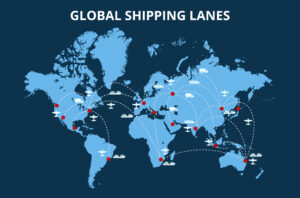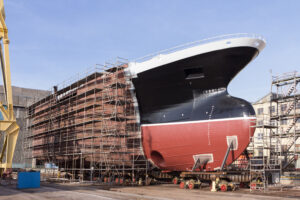- Is One Section of River Traffic Fading Away?
SOME DATA ON THE RIVER OPEN HOPPER BARGE MARKET
I recently received a question on the market for river service open hopper barges.
The answer starts with information from the U.S. Energy Information Agency (EIA). EIA statistics show that the Capacity Weighted Average Construction Cost of solar voltaic generators has fallen about 50% between 2013 and 2018. Offshore wind generator costs are down 27% and natural gas 17%.
“Traveling by boat is the best way to travel, unless one can stay at home.”
– Mark Twain
The average construction cost in 2018 for wind farms were $1676 per MW for 25-100 MW farms, $1435 for 100-200 MW farms, and $1268 for 200+ MW farms. All these per megawatt costs have been steadily dropping since 2014.
The cost of natural gas fired generators in 2018 was a low of $604 for turbine units and twice that, $1211 for internal combustion engines. These annual cost vary with the cost fluctuations of natural gas.
EIA also states that from 2011 to mid-2020 75 gigawatts of coal capacity was shut down or switched to a different fuel source. Another 25 GW is slated to be shut down by 2025.
From 2008 to 2018 domestic coal shipments to the U.S. power sector, by all forms of transportation, fell about 57%. In 2018, the coal shipped to power plants by barges dropped 9%.
The U.S. Army Corps of Engineers (USACE) Waterborne Commerce Tables show that coal shipments from 1997 to 2014 averaged around 300,000,000 short tons, plus or minus no more than 10%. In 2015, it fell to 233,900,000 ST, and in 2016, the latest in the table, 197,700,000 ST.
Domestic coal production peaked in 2008 and in 2018 it was the lowest it has been since the coal miner’s strike in 1978.
The statistics show the trend away from coal is obvious and can’t be ignored.
Most coal is carried by rail, but some of this is from inland coal areas, such as the largest coal producer Wyoming. Rail cars take some of it to rivers for transshipment to barges, but rail car loadings are down about 50% now over a high of around 100,000 carloads in early 2018.
EIA indicates a 25-30% decrease in exports in 2020 from the same period in 2019, and sees this 30% drop through all of 2020.
Where does this leave the demand for open hopper barges?
The USACE marine tonnage tables as of 2018 showed a total of 8122 open hopper barges. This number includes the 175 x 26 and 195 x 26 open hoppers in upper river service, like the Ohio River.
The oldest open hopper was built in 1972. A total of 978 (12%) were older than 35 years, and 1464 (18%) were younger than 10 years. The two largest construction years shown in their tables were 2007 and 2008 when a total of 589 barge were delivered.
Closer to most market interest are the statistics on just the standard Jumbo 195/200’ x 35 x 12/13/14’ open hoppers. The IEG Vantage Barge Fleet Profile 2019 lists, as of 2018, a total of 5909 in that specific category. It should be noted that the Barge Fleet Profile works with operators by sending out questionnaires and there is not 100% participation. Barge operators, large or small, may not provide data. The average age of these barges is 17.6 years. (The average age of covered hopper barges is 13.5 years.) The Profile also shows that in 2015, 338 open hoppers were built, a statistic not noted by the USACE. However, in another table it shows that there were only 117 2015 built open hoppers in use in 2019. This may be due to some operators of 2015 barges not participating in the Profile.
A wider overview on demand factors
International trade is one factor. But the big name in trade uncertainty, China, is not an important market for U.S. coal exports. The largest importer is India with their demand for steamer coal for electricity generation. Next is Japan with a near equal need for metallurgical and steamer coal. The Netherlands is 3rd as mainly a transshipment hub for the rest of Europe, mainly Germany.
Other top ten buyers are Brazil (metallurgical), South Korea (steam), Canada and the Ukraine (metallurgical), Egypt (steam), and Italy and Morocco (mainly metallurgical).
Weather affects utilization, with cold or hot weather increasing home and commercial electrical demand. Storms and icing shut down navigation causing barges to sit as temporary floating storage units. This latter situation can also occur when the Corp of Engineers has to shut down a lock system due to damage or maintenance.
There can also be individual operators that have to spend capital on Subchapter M upgrades to tug boats making the operation of some utilization/low income open hopper barges of no interest.
A small silver lining in this market is that some of the barges have been used to ship wind farm blades. But this will not balance the loss of coal, or the softer market for things like fracking sand.
THE MARKET PLACE
Hopper barges in general do not often come up on the open market. They can change hands among lessors at the end of lease transactions but these are usually en bloc sales with the numbers rarely public knowledge.
Currently brokers have shown a few of these open hoppers on the market. Sales have ranged from a single barge to a group of 19. Their ages ranged from the mid 1970’s to the year 2001 with asking prices running from around $125,000 to $250,000. These asking prices equal about 25% to 50% of replacement costs.
The catch here is that replacement costs over the last 10 years has varied greatly between around $450,000 and $600,000, depending on the cost of steel and the leverage the builder had with profit margins. And there is no apparent connection between the ages of these barges and their asking prices. Age and asking price had no connection.
From this information it seems that the asking market price is going to vary by the specific condition of the barge and the owner’s interest in selling.
INTERNATIONAL VALUATION STANDARDS
Lenders are familiar with the domestic Uniform Standards of Professional Appraisal Practice (USPAP) the standards for appraisal reports on Real Property, Personal Property and Business Valuation. With our appraisers all being members of the American Society of Appraisers, our appraisal reports have been USPAP compliant for over 20 years.
Internationally, a non-profit registered in the United States and headquartered in London, The International Valuation Standards Council, has worked with interested parties throughout the world to produce standards for appraisal reports that international investors and accounting firms can rely on for detailed, transparent and unbiased valuations. These standards are in many ways similar to USPAP. DLS has followed the progress of IVS and has had several engagements with international banks where an IVS compliant appraisal was requested.
Most of the thrust of IVS is on Business Valuation and the value of intangibles, but Personal Property is included in their guidelines. For now, because the U.S. works under the rules of GAAP (Generally Accepted Accounting Standards) and internationally it is IFRS (International Financial Reporting Standards), USPAP and IVS have similar goals via slightly different routes. However it is in the interest of worldwide industry and investors to have common regulations and FASB and IASB, the U.S. and international accounting standards boards, are working towards one standard.











